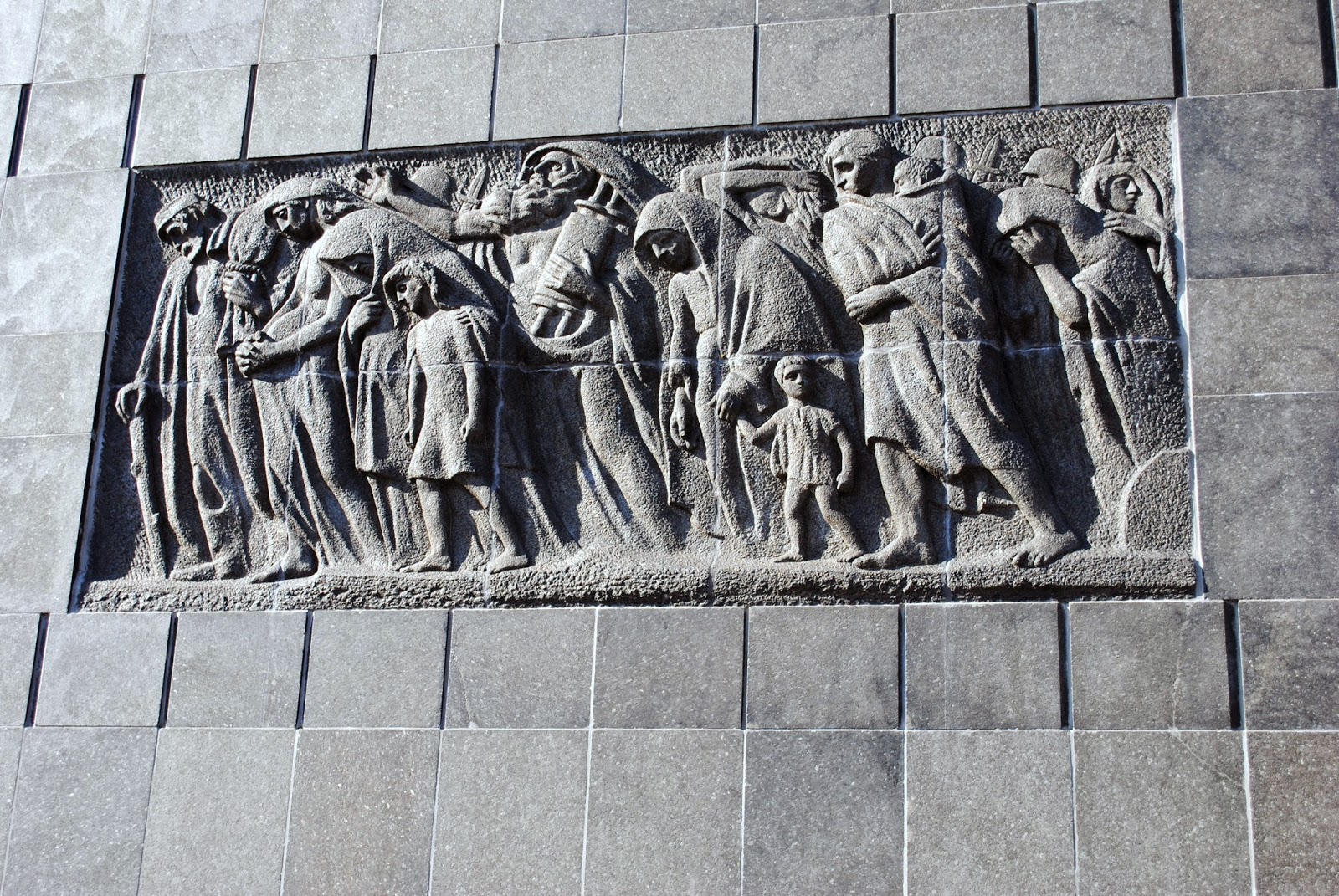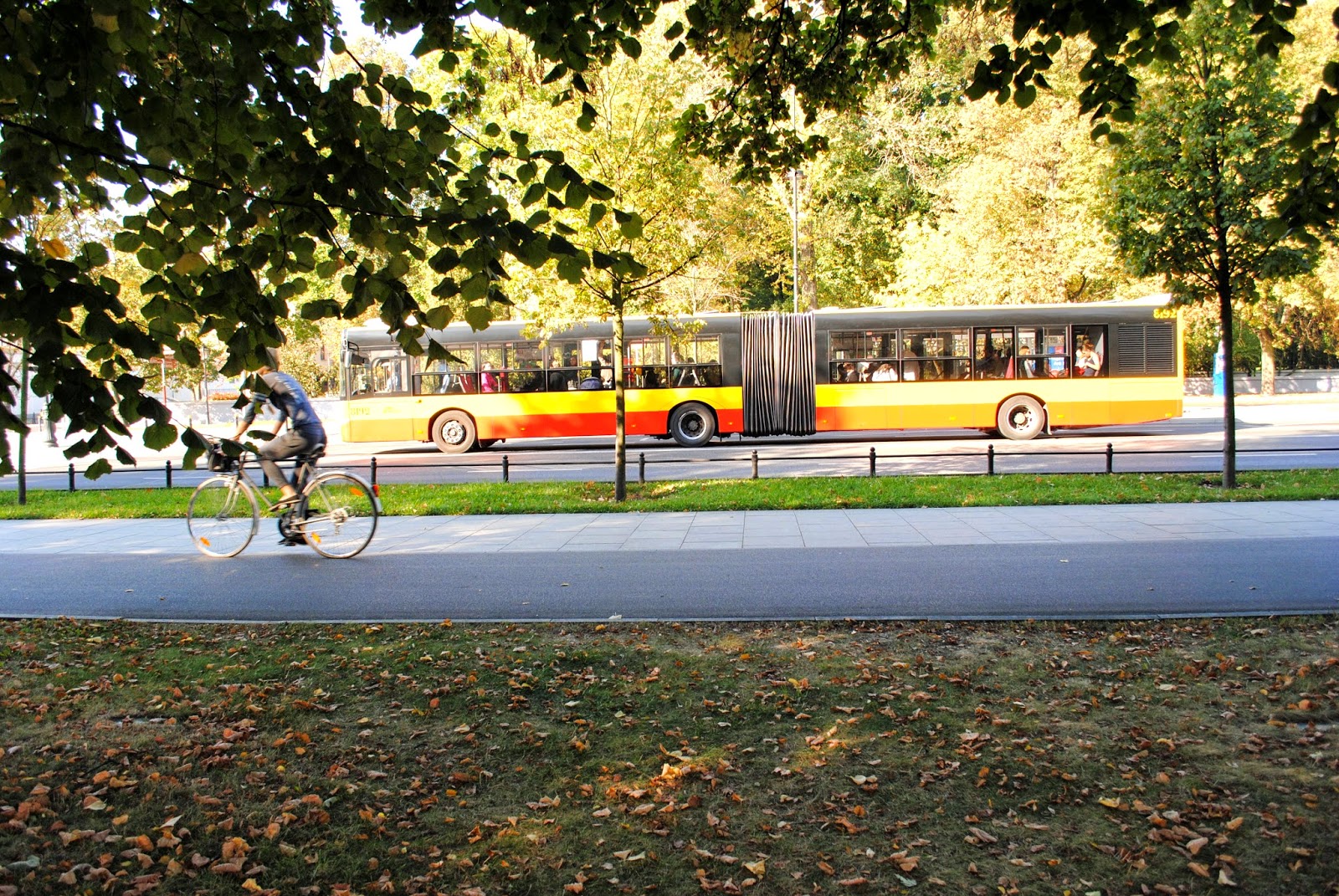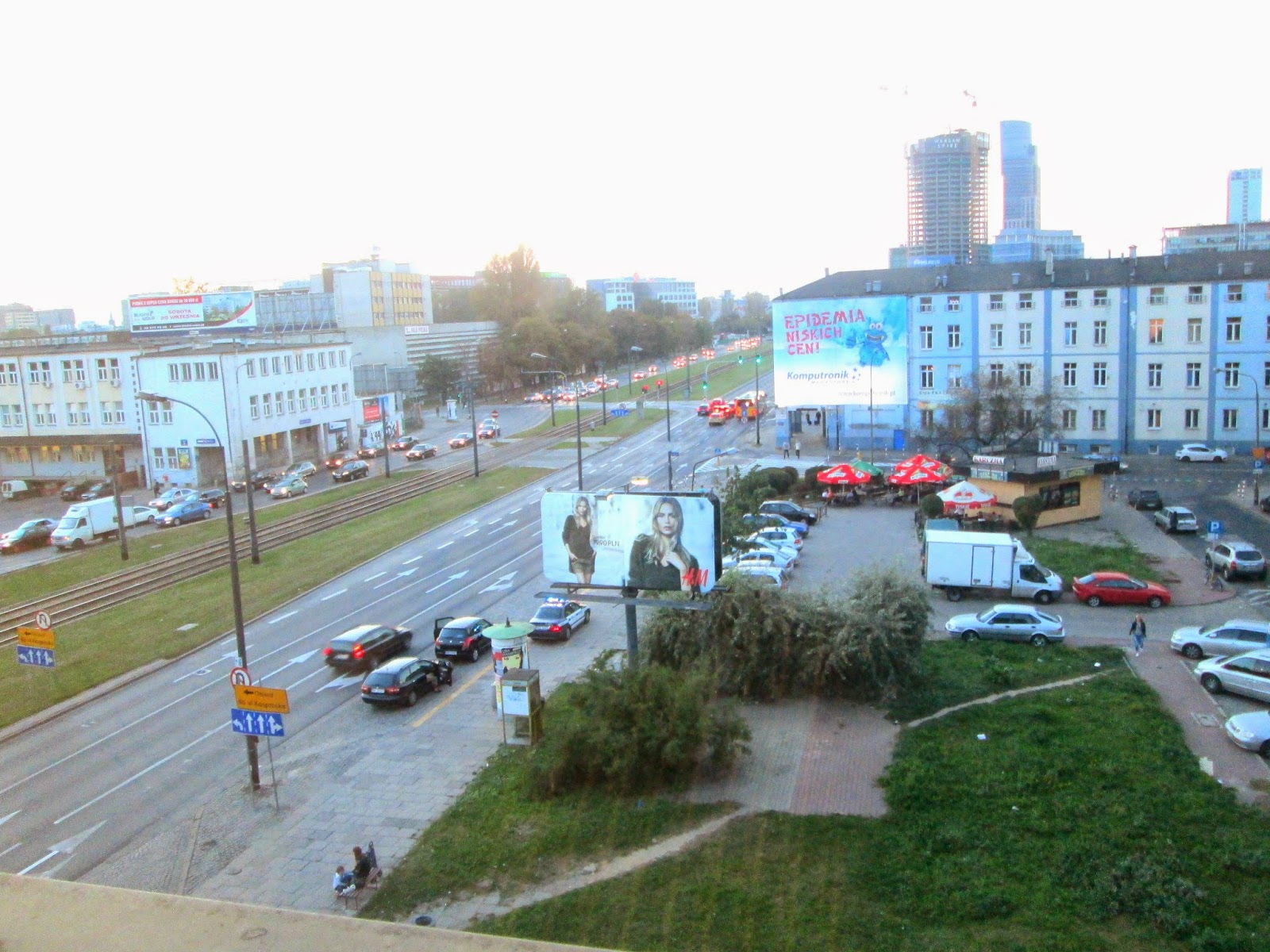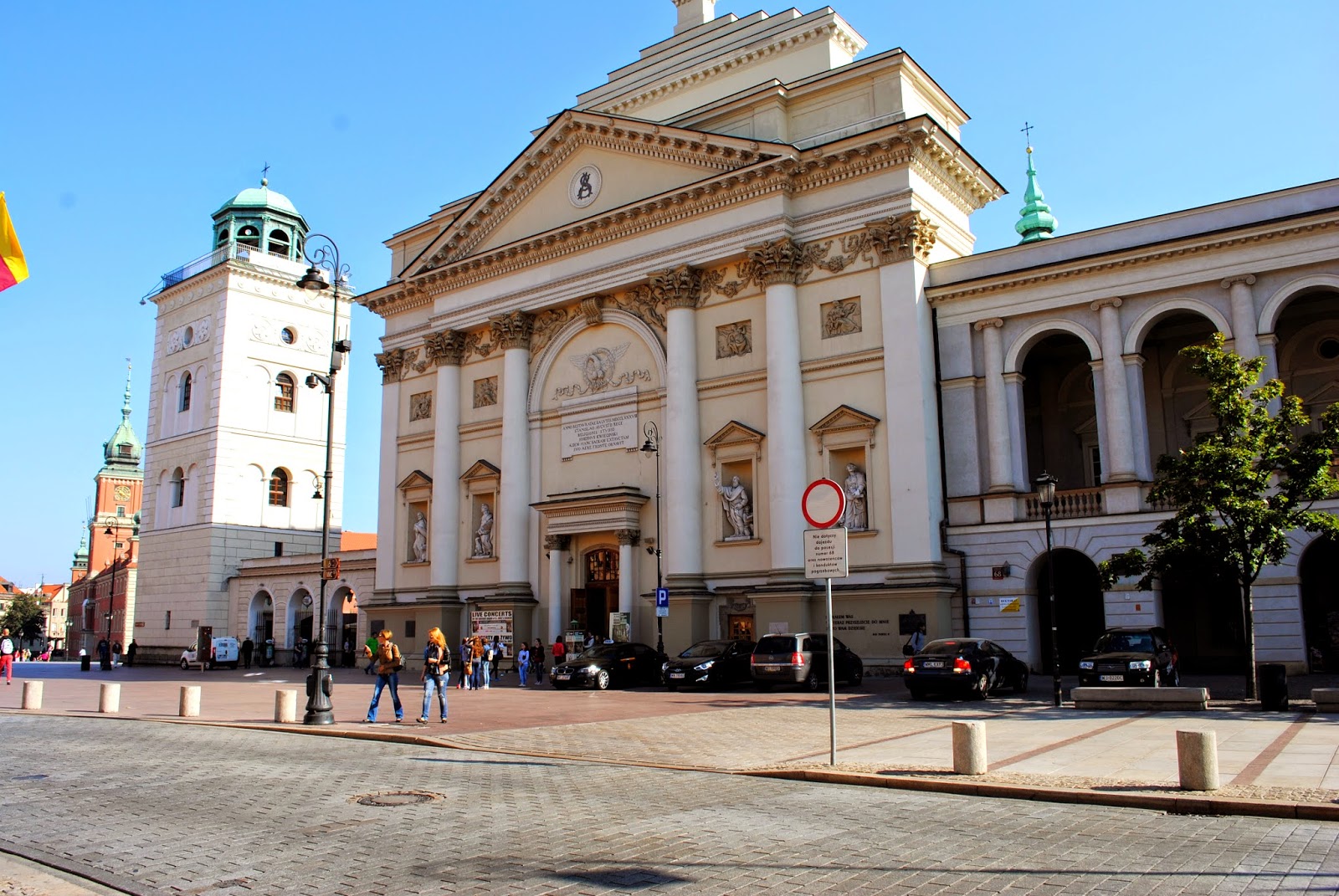The World is a book, and those who do not travel read only a page" - Saint Augustine
Warsaw – the capital of Poland.
This amazing city is full of contrasts, question marks and surprises. It is bound excite and inspire you. It is indeed a city, full of astonishing contrasts and it never ceases to amaze people, with its magnitude of dimensions and themes, which are there to be discovered, absorbed and understood by the inquisitive.
The weather was bright and sunny, with just a slight chill in the air: perfect for touring the city.
We were shown a few places from our coach and later we were left near the Royal Castle to do some sight seeing and shopping on our own. (Although there are many shops selling Amber, the local guide showed us where we could by without being cheated).
We passed by some important monuments and also stopped at a few interesting ones.
Some of the places where we stopped were: Monument to the Ghetto Heroes, Fryderyk Chopin Monument, and Krakowskie Przedmieści, also known as the Royal route,
Krakowskie Przedmieście Royal Avenue constitutes the northernmost part of Warsaw's Royal Route, and links the Old Town and Royal Castle (at Castle Square) with some of the most notable institutions in Warsaw, including – proceeding southward – the Presidential Palace, Warsaw University, and the Polish Academy of Sciences headquartered in the Staszic Palace. The immediate southward extension of Krakowskie Przedmieście along the Royal Route is ulica Nowy Świat (New World Street)
Warsaw is a big city, and I feel what I saw was just a glimpse, but never the less you are invited to come along with me and see some places visited by me in Warsaw:
The monument to the heroes who died during the Ghetto Uprising in 1943 The monument features an inscription in Polish, Yiddish, as well as Hebrew which reads: 'The Jewish People in honour of its fighters and martyrs'.
In an ironic quirk, the stone cladding on the monument was originally ordered from Sweden by Hitler for a victory arch.
The back side of the memorial depicts a line of Jewish prisoners marching to a certain death in the concentration camps.
The Warsaw Uprising is an exceptional chapter in the city’s history - one that is both heroic and tragic. The monument commemorates the thousands of heroes of the 1944 Warsaw Uprising who gave their lives for their homeland, having fought against the occupiers for 63 days under woefully uneven odds. It is a two-part monument. The first part presents the fighters as they crawl out from under a bridge support, while the second part shows them entering the canal system. An entryway into the canal system used to escape from the Germans was located on Plac Krasińskich.
Warsaw is also a city that very deeply demonstrates its memory of the most painful events of the Polish . Remembering the people who have lost their lives fighting for their country.
Commemorative plaques and monuments, honoring victims of Nazi and Russian persecution, can be seen almost on every street or a square.
Golden Terraces shopping center/ Mall :
It has attracted prestigious tenants including Central Europe's first Hard Rock Cafe restaurant, famous for displaying music mementos including Bono's and John Lennon's guitars.
Its design, crisscrossed by various levels, stairs and passages, gives the impression of the complex being suspended in the air. The lightness is enhanced by its open structure. Placing the colorful mechanisms of the escalators behind glass panels was a great idea. The roof is more than a masterpiece of engineering: it is a work of art.
The shopping center has a sophisticated glass roof that consists of thousands of separate glass elements and extends in the form of a wave over the roof .
The shape and style of the undulating glass roof was inspired by the tree canopies in Warsaw's historic parks.
The Palace of Culture and Science is the highest building in Poland. It has over 3,000 rooms.
The big attraction is a large terrace on the 30th floor of the Palace.It was built between 1952 and 1955; it was a "gift of the Soviet people to the Polish nation", offered by Joseph Stalin himself. The architect was Lew Rudniew.
The Palace has a post office, cinema, swimming pool, museums, libraries and theaters. The palace is one of the largest conference facilities in Warsaw, comfortably accommodating more than 4,500 participants at a time, at dozens of meetings and training conferences annually.
The big attraction for tourists and residents is the 'trzydziestka', a large terrace on the 30th floor of the Palace (at a height of 114 m), where you can admire the gorgeous panorama of Warsaw. On New Year’s Eve, 2000, the Palace of Culture and Science unveiled the second largest clock in Europe: its four discs are each 6 m in diameter, and it is highest clock tower in the world.
However, the people here really hate this building, for it is a sad reminder to them of the Soviet dominance over Poland. Many wish that, this monster of a building would somehow disappear. A common joke is that it offers the best view of the city – the only place from which you don't have to see the building itself.
We just saw it from outside, somehow didn't feel like wasting money to see something so hated by the people of Poland. The guides never get tired of expressing their hatred for this awful building.
Here in Warsaw it is a bit sad to see the historic, baroque and neoclassical buildings meet solid houses from the 50s, shoddy constructions of 70s and glass office buildings of modern time.
Some areas are very good too with large, clean parks. This is Warsaw early in the morning. Poland is really a clean country. Their roads are all so wide: it is really nice to see such wide roads everywhere.
Some areas are very good too with large, clean parks. This is Warsaw early in the morning. Poland is really a clean country. Their roads are all so wide: it is really nice to see such wide roads everywhere.
A plaster-cast of the original model allowed the statue to be rebuilt and a reconstruction was unveiled in 1958. This Statue depicts the composer sitting under a willow tree seeking inspiration from nature. The stylized willow over Chopin’s seated figure echoes a pianist’s hand and fingers.
You can listen to Chopin’s compositions for free at this self playing bench, not only in this park but many other parks too.
From the early 17th until the late 18th century, this was the seat of the Polish kings. It subsequently housed the parliament and is now a museum displaying tapestries, period furniture, funerary portraits and collections of porcelain and other decorative arts.
Behind me is the Vistula River, Polish Wisła.
Feeling quite pleased with my Amber, which I purchased there. Poland is famous for its Amber.
Baltic Amber: which is Polish gold is everywhere in this city and it's an excellent buy. You’ll find everything from simple amber beaded necklaces to lamps, furniture, and all sorts of collectible items brilliantly crafted by the country’s artisans.
Even if you have zero interest in buying amber, you’ll find yourself fascinated by Baltic Amber, which is fossilized tree resin (not sap) that dates from 44 million years ago. The most valuable pieces have extinct insects and plants inside of them which you can see in the exhibitions through magnifying glasses.
Baltic Amber actually comes in a range of colors, from a smoky white to almost black and of course, the yellow-orange-brown color most associated with it. There are uncommon colors as well including red, green and a blue which is very rare.
In Poland, when you buy amber, you will always be given a Certificate of Authenticity, even for a tiny piece. So don't forget to buy some Amber when you are in Poland.
All over Europe one can find locks of various sizes on the railings of bridges ( this is not a bridge, but here too one can find locks: some superstition)
Everything blue here from my top to the beautifully painted blue wall.
The Old Town was reconstructed from original plans and paintings from the 17th and 18th centuries - it's hard to believe it's just a half a century old when you stroll its quaint cobbled streets : amazing!
St. Anne's Church near the Royal Castle Square
The view of the wide roads of Warsaw from the Castle.
The Royal Castle Square:
This monument (column of King Zygmunt) is a great spot to relax for a while. You get a view of all the activity in the area..shops, cafe's etc., and indulge in some people watching. A good place to rest your tired feet, after walking and exploring the various narrow cobbled streets, shopping, and eating.
This huge clock tower of 60 m in height designed in the sixteenth century, has always been a symbol of the Polish capital and source of inspiration for the architects of other buildings in Warsaw.
Krakowskie Przedmieście, in Warsaw (literal English meaning: "Kraków Suburb"; until the 19th century, also known by the French rendering, "Faubourg de Cracovie") is one of the most impressive and prestigious streets of Poland's capital.
It is the northernmost part of the Royal Route, and links the Old Town and Royal Castle with some of the most notable institutions in Warsaw, including — proceeding southward — the Presidential Palace, Warsaw University, and the Polish Academy of Sciences (headquartered in the Staszic Palace).
In accordance with Fryderyk Chopin's will, after his death his heart was removed, placed in an urn, and brought by his sister to Warsaw, where it was deposited inside a pillar in the Holy Cross Church on Krakowskie Przedmieście.
You can get the idea of what Warsaw looked like back then from a famous scene in the Pianist, when Adrian Brody (playing Wladyslaw Szpilan) emerges from his final hide-out and looks at completely ruined Warsaw stretching for miles.
Surviving architects after the war searched for old photographs, plans and documents in an attempt to ensure an exact reconstruction of the Old Town.
No wonder, Warsaw is a phoenix, a city that rose like a phoenix from the ashes and all because of its hard working people. If interested see this video:
Next I will take you to tour Krawkow with me. Are you ready or are you already tired?
You can listen to Chopin’s compositions for free at this self playing bench, not only in this park but many other parks too.
Look at the colors of the buildings they are so soothing to the eyes.
The Royal Castle Square:
Warsaw’s striking Old Town may look like it dates back several centuries but the old town has barely reached middle age. The painstakingly rebuilt area was awarded a listing on UNESCO’s World Heritage List in 1980.
Walking through the Royal Castle, you have to remind yourself constantly that most of it was reconstructed between 1971 and 1984. The castle is located on a plateau overlooking the Vistula River.The Royal Castle Square:
Warsaw’s striking Old Town may look like it dates back several centuries but the old town has barely reached middle age. The painstakingly rebuilt area was awarded a listing on UNESCO’s World Heritage List in 1980.
From the early 17th until the late 18th century, this was the seat of the Polish kings. It subsequently housed the parliament and is now a museum displaying tapestries, period furniture, funerary portraits and collections of porcelain and other decorative arts.
Feeling quite pleased with my Amber, which I purchased there. Poland is famous for its Amber.
Baltic Amber: which is Polish gold is everywhere in this city and it's an excellent buy. You’ll find everything from simple amber beaded necklaces to lamps, furniture, and all sorts of collectible items brilliantly crafted by the country’s artisans.
Even if you have zero interest in buying amber, you’ll find yourself fascinated by Baltic Amber, which is fossilized tree resin (not sap) that dates from 44 million years ago. The most valuable pieces have extinct insects and plants inside of them which you can see in the exhibitions through magnifying glasses.
Baltic Amber actually comes in a range of colors, from a smoky white to almost black and of course, the yellow-orange-brown color most associated with it. There are uncommon colors as well including red, green and a blue which is very rare.
In Poland, when you buy amber, you will always be given a Certificate of Authenticity, even for a tiny piece. So don't forget to buy some Amber when you are in Poland.
All over Europe one can find locks of various sizes on the railings of bridges ( this is not a bridge, but here too one can find locks: some superstition)
Everything blue here from my top to the beautifully painted blue wall.
The Old Town was reconstructed from original plans and paintings from the 17th and 18th centuries - it's hard to believe it's just a half a century old when you stroll its quaint cobbled streets : amazing!
St. Anne's Church near the Royal Castle Square
The view of the wide roads of Warsaw from the Castle.
The Royal Castle Square:
This monument (column of King Zygmunt) is a great spot to relax for a while. You get a view of all the activity in the area..shops, cafe's etc., and indulge in some people watching. A good place to rest your tired feet, after walking and exploring the various narrow cobbled streets, shopping, and eating.
Krakowskie Przedmieście, in Warsaw (literal English meaning: "Kraków Suburb"; until the 19th century, also known by the French rendering, "Faubourg de Cracovie") is one of the most impressive and prestigious streets of Poland's capital.
It is the northernmost part of the Royal Route, and links the Old Town and Royal Castle with some of the most notable institutions in Warsaw, including — proceeding southward — the Presidential Palace, Warsaw University, and the Polish Academy of Sciences (headquartered in the Staszic Palace).
In accordance with Fryderyk Chopin's will, after his death his heart was removed, placed in an urn, and brought by his sister to Warsaw, where it was deposited inside a pillar in the Holy Cross Church on Krakowskie Przedmieście.
You can get the idea of what Warsaw looked like back then from a famous scene in the Pianist, when Adrian Brody (playing Wladyslaw Szpilan) emerges from his final hide-out and looks at completely ruined Warsaw stretching for miles.
Surviving architects after the war searched for old photographs, plans and documents in an attempt to ensure an exact reconstruction of the Old Town.
No wonder, Warsaw is a phoenix, a city that rose like a phoenix from the ashes and all because of its hard working people. If interested see this video:
Next I will take you to tour Krawkow with me. Are you ready or are you already tired?





























Never tire from your trips, Rama! Thanks for taking us along!
ReplyDeleteHello Jerry,
DeleteI was just thinking about you, and here I come and see a comment from you. Makes me think it must be telepathy doing its job. I am glad you liked the trip with me.
Amazing photographs!!The description is so vivid, I felt was also there.
ReplyDeleteThanks Usha, I am so glad you liked it.
DeleteWow! That was an amazing virtual trip to Warsaw. Your travelogues are so informative and exhaustive, replete with fabulous pictures. Thanks for sharing, Rama and looking forward to much more :)
ReplyDeleteThe photo in the header is beautiful...blue blue everywhere and your dress too! You dress up very well, Rama.
ReplyDeleteAmber is beautiful. You have narrated about the place nicely. The place is very familiar to me because the books I have read about the World wars. Should visit here soon. Thank you.
Thanks for the wonderful travelogue and beautiful photos. Did you have a chance to visit Auschwitz while on this tour?
ReplyDeleteYour narration took me to these lovely places, you never ever miss out on any point! I especially loved the colorful row of houses that seems like out of this world!
ReplyDeleteThat was a descriptive and visual tour to Warsaw from my arm chair. Loved your header photo. Waiting to travel to Krawkow through your post.
ReplyDeleteWonderful and envious too. East Europe- has history and charm that many other places do not have and certainly not the skyscraper filled cities of the new world. Good read and decent pics.
ReplyDeleteCould nt open the video though.
O!Rama thank you for keeping us go round the world without visa, along with you.Beauty of pictures strike our eyes and description steals our imagination.Nice.
ReplyDeleteThank you for the wonderful virtual tour Rama. Your vivid description made me feel like I was there right behind you... The musical bench and the amber are interesting features.
ReplyDeleteA Phoenix story, indeed. Polish people have suffered a lot during the WWII. They are a proud people, with a long, courageous history. In medieval times especially, ours and theirs history mingled a little. I admire them for their determination and pride. Poland is one of the countries which did best after entering the European Union.
ReplyDeleteI am sure you would visit soon, and not wait like us . Thanks.
ReplyDeletehi Rama didi how was your trip it's been so long since I've been on your blog!!! miss you so much to tell you will email you soon!!!! love you tour Kelly
ReplyDelete